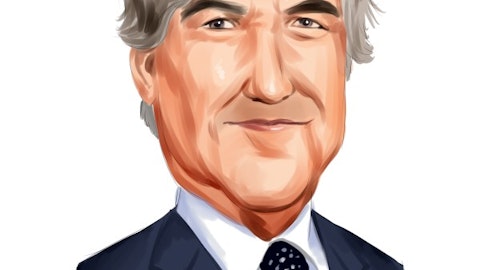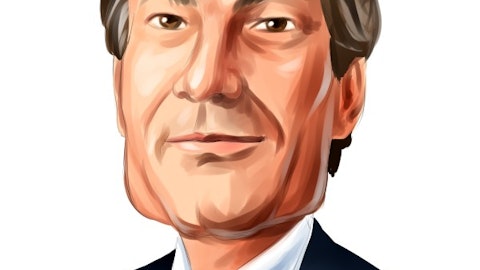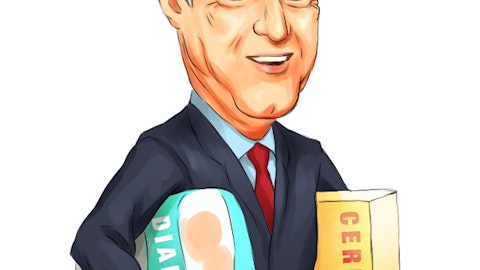Hawaiian Electric Industries, Inc. (NYSE:HE) Q1 2023 Earnings Call Transcript May 9, 2023
Operator: Good afternoon. Thank you for attending today’s Q1 2023 Hawaiian Electric Industries Inc. Earnings Conference Call. My name is Alexis, and I will be your moderator for today’s call. I would now like to pass the conference over to Mateo Garcia, Director of Investor Relations. You may proceed.
Mateo Garcia: Thank you, Alexis. Welcome everyone to HEI’s first quarter 2023 earnings call. Joining me today are Scott Seu, HEI President and CEO; Paul Ito, HEI CFO; Shelee Kimura, Hawaiian Electric President and CEO; and Ann Teranishi, American Savings Bank President and CEO; and other members of senior management. Our earnings release and our presentation for this call are available in the Investor Relations section of our website. As a reminder forward-looking statements will be made on today’s call. Factors that could cause actual results to differ materially from expectations can be found in our presentation, our SEC filings under the Investor Relations section of our website. Now, Scott will begin with his remarks.
Scott Seu: Aloha kakou. Greetings everyone. Thank you for joining us today. I’ll give an overview of our results, update you on our businesses and the Hawaii economy, and then turn the call over to Paul to further discuss our financial results and guidance. Our combination of businesses continued to deliver solid results in the first quarter. ASB’s low-risk community banking model, supported by a strong primarily retail deposit franchise showed its resilience. And with 86% of deposits from our retail customers and 85% of total deposits F.D.I.C. insured or fully collateralized ASB is a very different bank than the banks that have experienced challenges in recent months. The utility continues to show its ability to deliver consistent performance under performance-based regulation or PBR and operate efficiently to deliver earnings growth.
Our consolidated first quarter earnings of $54.7 million, and earnings per share of $0.50 reflects strong execution from across our enterprise. The utility executed well growing net income to $47 million despite elevated costs from storms during the quarter. And ASB grew net income over the fourth quarter of last year generating net income of $18.6 million. As a reminder, last year’s first quarter results included a $0.06 per share gain on sale in the holding company and other segment. Turning to the utility. We continue to progress key initiatives to integrate more renewables while improving the reliability and resilience of our grids. In late March, we filed our draft Integrated Grid Plan or IGP which proposes a clear plan forward to meeting our state’s clean energy goals, while prioritizing reliability and affordability.
The draft IGP identifies four key objectives within the next five years, including stabilizing utility rates and advancing energy equity growing the marketplace for customer scale and large-scale renewables creating a modern and resilient grid, and securing reliability through diverse energy sources and technologies. Our IGP is crucial to achieving our state’s clean energy goals of net-zero carbon emissions and 100% renewables by 2045. Our Stage 3 RFP has continued to progress as planned. Bids were submitted in April and the utility has bid in for firm renewable generation consistent with the reliability requirements under the competitive bid framework. The RFPs are seeking a total of over 1,700 gigawatt hours of energy annually and between 600 and 800 megawatts of firm renewable capacity.
Bid award notifications for Hawaii Island, Oahu and the variable and storage components of Maui’s RFP are expected in late October. We are continuing to connect renewable projects and the infrastructure required to deploy renewables reliably and efficiently to our grids. Last month, we placed in service a 30-megawatt solar project that includes 120-megawatt hours of storage on Hawaii Island. We also now have 0.25 million smart meters deployed servicing over 50% of our customers. These meters help us to integrate more renewables and to get distributed energy resources connected to our system faster, while providing data that helps us operate our grid more efficiently. We also plan to connect the 185-megawatt Kapolei Energy Storage project to our grid this summer.
The project will provide load shifting and fast frequency response services enhancing grid reliability as we continue accelerating the integration of renewable energy. Turning to the bank on slide 4. ASB remains well-positioned operating in Hawaii’s unique banking market, which is characterized by loyal customers, a healthy economy and stable real estate values. Our depositor base 86% of which comprises retail deposits has remained a steady source of funding during the quarter with no unusual changes to customer behavior as a result of challenges elsewhere in the banking industry. ASB remains a consistent contributor to earnings and cash flow. And during the quarter paid HEI $14 million of dividends. We continue to see positive trends in credit quality and our high-quality loan book most of which is real estate secured saw a continuation of historically low delinquency rates and net charge-offs and overall solid condition of our borrowers during the quarter.
ASB’s unique banking market strong liquidity and capital ratios and high-quality retail deposit base give us confidence we are well-positioned to continue delivering solid financial results. Turning to the economy on slide 5. Hawaii’s economy continues to show strength across key indicators. And the University of Hawaii Economic Research Organization, which provides regular forecasts of our state’s economy is still projecting growth in Hawaii in 2023 driven by a continued recovery of tourism and expected strong military construction spending. Hawaii’s unemployment rate was 3.5% in March an improvement from 3.6% in February and in line with the national average. As a reminder, unemployment here has fared comparatively well during downturns and performed better than the national average during the financial crisis.
Visitor arrivals are near pre-pandemic levels. In March about 901,000 visitors arrived in Hawaii, an increase of 14% from last year and a 97% recovery from March 2019. International arrivals nearly doubled compared to last year in March with Japanese arrivals increasing tenfold. Notably visitor spending has been very strong. And in March it was up over 20% compared to last year and up over 23% compared to pre-pandemic levels. Hawaii’s housing market has also been resilient. And while sales volumes are lower given high mortgage rates median prices at about $1 million in April are still hovering near record highs. I’ll now hand the call over to Paul to further discuss our financial results and outlook.

Photo by Ronan Furuta on Unsplash
Paul Ito: Thank you, Scott. I’ll start with our results for the quarter. We generated consolidated net income of $54.7 million and EPS of $0.50 compared to $69.2 million and EPS of $0.63 last year. As a reminder, our results in the prior year’s quarter included a $0.06 per share gain on the sale of the EverCharge equity investment recorded at Pacific Current and also reflected bank earnings that were elevated by a net benefit from the release of reserves. Our consolidated last 12 months ROE remains healthy at 10% which is down from 10.9% last year due to lower bank earnings and the previously mentioned gain at Pacific Current in the prior year. Utility ROE continues to improve and increased 10 basis points to 8.2%. And bank ROE on an annualized basis was up 180 basis points compared to the same quarter last year given the impacts of unrealized losses in the investment securities portfolio on shareholders’ equity.
On slide 7 we show major variances across the enterprise compared to the first quarter of last year. Lower bank net income was primarily due to higher non-interest expense which was driven by higher compensation and benefits costs, a higher provision compared to the negative provision recorded in the first quarter of last year and lower non-interest income due to a gain on sale of real estate recorded in the fourth quarter of last year. These items were partially offset by higher net interest income primarily due to higher interest and dividend income partially offset by higher interest expense. On the utility side on an after-tax basis we saw $7 million in higher annual revenue adjustment or ARA revenues, $1 million higher AFUDC and $1 million higher major project interim recovery mechanism revenues.
These were partially offset by higher O&M primarily from higher storm restoration costs and higher depreciation higher interest expense from higher borrowings and higher heat rate. The holding company and other segment variance was driven by last year’s gain on sale at Pacific Current and in the current year lower performance from Pacific Current and higher holding company interest expense. Turning to Slide 8. Utility CapEx for the quarter was $112 million, nearly twice the CapEx in the first quarter of 2022. For the full year, we continue to forecast CapEx in the $370 million to $410 million range. On Slide 9, we show utility earnings drivers for the remainder of the year. The utility has performed well so far this year operating efficiently and managing O&M despite $2.8 million in higher pre-tax expenses related to the storms we saw in the first quarter.
Efficient execution will remain a key area of focus for us for the remainder of the year as we work to manage O&M increases within the 3.68% inflationary adjustment allowed under the ARA. Performance incentive mechanisms or PIMs will also be a key driver of our full year earnings. Fuel prices have moderated from the beginning of the year with no significant impact from the fuel cost risk-sharing mechanism. As a reminder, benchmark prices are set on January’s full prices for each fossil field type and prices in the first quarter trended below those benchmarks. Lower fuel prices have also contributed to lower customer bills and rates on all islands are now lower than they were last spring when we started feeling the impacts of Russia’s invasion of Ukraine.
We remain on track to be within the $1 million to $3 million guidance we issued in February for the RPS-A PIM. And as Scott mentioned, we’ve been making good progress connecting renewable projects to our grid. In summary we still expect total net PIMs of approximately $4 million for 2023. Turning to the bank on Slide 10. This slide shows key differentiators that underpin the solid low-risk and predictable community banking model that has consistently contributed to HEI’s earnings and cash flow for many decades through many different cycles. As a community bank with a focus on relationship banking, the vast majority of our customers are 86% comprise the retail segment. Our retail customer base is loyal and long tenured with nearly 50% of our retail customers having been with us for more than 10 years.
We also have strong commercial customer relationships with nearly 40% of our commercial accounts having a tenure of more than 10 years. In addition to the tenure of our customer deposits which contributes to funding stability, 85% of ASB’s deposits are FDIC insured or collateralized. This is a very high level of insured deposits and is a key differentiator that contributes to deposit stability. Despite the mainland bank turmoil during the quarter, total average deposits were essentially flat down a modest 0.8% in the first quarter of 2023. On an end-of-period basis total deposits were up 0.7% since the end of last year. In short, we did not see unusual customer behavior as a result of the mainland bank failures. And our consistent reliable and sticky retail deposit base continues to provide us with a predictable and low-cost source of funding.
Turning to Slide 11. ASB’s conservative underwriting and management practices have allowed us to build a loan book of exceptional quality. ASB’s focus is straightforward real estate secured lending within our Hawaii communities that we know and understand. The vast majority of ASB’s loan book 82% is backed by real estate. Our lending is done at conservative loan-to-value ratios which stand at less than 50% for residential and less than 55% for commercial real estate on a weighted average basis. There has been a lot of focus on the quality of commercial real estate or CRE loan portfolios of regional banks in recent months. Our CRE loan portfolio is diversified and well margined against property value declines and we have had historically minimal loss experience within our CRE portfolio.
In fact, through the Great Financial Crisis and its aftermath we had no charge-offs of commercial real estate loans. Office loans have also been an area of focus for regional banks. Our office CRE loans have strong credit metrics and comprise only 2% of our total loan portfolio. Turning to Slide 12. Higher interest rates have continued to benefit our yield on earning assets, which was up 21 basis points in the first quarter to 3.49%. Last quarter, we said that we were seeing pressure from higher funding costs that we would need to pay down higher cost borrowings in order to expand net interest margin. Due to deposit trends in the sector we continue to see pressure like many banks our net interest margin from higher funding costs, although, our cost of funds remains relatively low compared to similarly sized peers.
Cost of funds for the quarter was up 28 basis points to 66 basis points, which was due primarily to a shift in funding that pressured our net interest margin. You can see at the bottom left of the slide, we’ve had a higher proportion of average wholesale borrowings to total funding sources in the first quarter at 8% versus 3% of our funding mix in 2022 although the amount of wholesale borrowings outstanding at end of the first quarter declined from year-end. During the quarter, our net interest margin was down six basis points to 2.85%. We expect similar dynamics to persist for the remainder of the year. Turning to drivers for the rest of the year on Slide 13. Due to the shift in funding mix mentioned, we are expecting net interest margin to be lower for the full year than previously anticipated.
We continue to focus on opportunities to pay down higher cost funding sources and operate efficiently. We expect the Fed to remain on pause for the remainder of the year. Provision for credit losses although hard to predict is also a crucial driver for our operation. We continue to see strong trends in credit quality with low net charge-offs compared to historical levels and we still expect provision to be in the 0 to $10 million range for the year. On Slide 14 we show our updated guidance expectations for the remainder of the year. We are reiterating our utility guidance of $1.75 to $1.85 per share. As mentioned, achieving performance incentive mechanism rewards while avoiding penalties and managing O&M expenses remain key areas of focus for management.
Turning to the bank’s outlook for the remainder of the year. Higher short-term interest rates and a challenging deposit environment have created margin pressures across the banking sector this year. Although, we’ve been able to keep our funding costs low compared to peers, we are still seeing some compression in net interest margin. And we now expect net interest margin for the year to be 2.8% to 2.9% versus our previous expectation of 3% to 3.15%. Due to higher funding costs we expect bank EPS to be at the low end of our EPS guidance range of $0.75 to $0.85. However it is still early in the year and uncertainty remains regarding how the Fed will proceed on interest rates and how our funding mix and costs will be impacted. Provision is also one of the more difficult items to predict.
So we will be revisiting the bank guidance range as the year progresses. We still expect holding company and other segment losses of $0.34 to $0.36 per share. We have seen slightly higher holding company and other segment expenses. As a result, we are expecting to be at the high end of that range. We do not anticipate any equity issuances for 2023. Based on the combined forecast for the segments consolidated earnings are expected to be in the lower half of the $2.15 to $2.35 guidance range. I’ll now turn it back over to Scott, who will provide closing remarks.
Scott Seu: Mahalo Paul, and mahalo to all of you for joining us today. In summary, we had a solid quarter. The utility continues to execute well under performance-based regulation and we’ve already hit important milestones this year in our clean energy transition. ASB’s conservative business model with our mostly retail and largely insured deposit base continues to prove its benefits. Our bank remains a low-risk, reliable and consistent contributor to earnings and cash flow. We continue to see strong value and consistent results from our combination of businesses. With that, let’s open up the call for questions.
See also 15 Best Interest Yielding Checking Accounts in the US and 13 Best Consulting Stocks to Buy Now.
Q&A Session
Follow Hawaiian Electric Industries Inc (NYSE:HE)
Follow Hawaiian Electric Industries Inc (NYSE:HE)
Operator: Absolutely. We will now begin the question-and-answer session. The first question comes from the line of Julien Dumoulin-Smith with Bank of America. You may proceed.
Julien Dumoulin-Smith: Mahalo. Good afternoon. Thank you team for taking this time, I appreciate it. Can you guys hear me?
Scott Seu: Hey Julien. Yeah, we can.
Julien Dumoulin-Smith: Hey. Thank you so much. Appreciate it. Hey, I was just curious, with respect — or first of kicking it off. I know you talked about overall not seeing too many changes on the bank deposit side but, have you seen any change in behavior for the uninsured deposits within the quarter, just talking about that component of the deposits?
Scott Seu: No. We’ve not seen any unusual, nothing like that Julien.
Julien Dumoulin-Smith: Okay. Excellent. Thank you. And then, maybe more substantively can you talk about some of the offsets to the reduced NIM and higher non-interest expense? Obviously, a few different pieces moving around, you described it in the prepared remarks. But what are the offsets keeping within the range? And then related here, if you can talk about that NIM percentage and the confidence that you have that will be unchanged for the balance of 2023. I think in particular ASB has been offering additional CD promotions since 3/31. Just what gives you that confidence on NIM as it stands under — as you described it today?
Paul Ito: Yeah. Hi Julien, this is Paul. Thanks for the question. So what we’re looking at in terms of offsetting some of that NIM pressure is of course managing non-interest expenses. And then, the other key factor is what provision will look like for the balance of the year. So maybe I’ll start with provision. So currently in Hawaii, we feel pretty optimistic about the rest of the year. We haven’t been seeing weakness in the economy. As you know, Yujiro had put out a report earlier and I think there’s one slated to be released soon. But they continue to have confidence in the Hawaii economy again, given the strong construction sector that we expect in 2023 as well as the International Tourism Recovery that we’re slowly seeing this year.
So I think the backdrop is favorable for fairly good in terms of credit quality going forward here, but that’s a key assumption. Again, we do expect continuing favorable credit trends. And then on the non-interest expense side we’re closely looking at expenses and how we can be more efficient. We’ve been taking a number of steps to reduce expenses across the organization. And so we’ve identified a number of cost-saving opportunities that we’ll be executing on. So those two things are what gives, us confidence in terms of achieving that NIM range. Now of course there — it depends on how things play out for the rest of the year right in terms of the economy in terms of credit quality. But at the moment we’re feeling pretty confident about those items.
Julien Dumoulin-Smith: Got it. All right. Excellent. And how are core deposits and CDs trended just even of late right in terms of post-quarter close?
Paul Ito: Yeah. So we have seen — after quarter end, we have seen average deposits decline. It was about $76 million in April. And April is I would say a little bit more of a vault to month in terms of deposits. It is the month where a lot of tax payments go out. So that wasn’t unexpected. I think historically, we’ve seen deposits compared to March, in April typically go down in general. What we saw was continued shift from core to sort of money market actually went up, so we continue to see that. So nothing, I would say, unusual, but we are continuing to see that trend overtime.
Julien Dumoulin-Smith: Excellent. Well thank you guys very much for the questions. Appreciate it and best of luck. We will see soon.
Scott Seu: All right. Thanks Julien.



